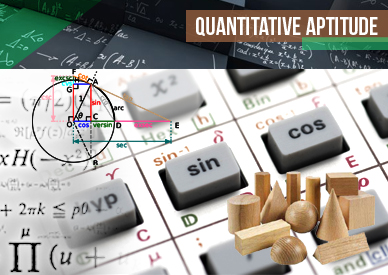Algebra For SBI PO : Set – 08
D.1-5) Each of the following questions contains two equation I & II. Solve those equation and find the value of x and y.
1)
I. 6x2+11x+4=0
II. 4y2-7y-2=0
a) If x > y
b) If x < y
c) If x ≥ y
d) If x ≤ y
e) If x = y or can’t be determined
Click Here To View Answer
b)
X=-1.3, -0.5 y=-0.25, 2
2)
I. x2-463=321
II. Y2-421=308
a) If x > y
b) If x < y
c) If x ≥ y
d) If x ≤ y
e) If x = y or can’t be determined
Click Here To View Answer
3)
I. 9x2-45x+56=0
II. 4y2-17x+18=0
a) If x > y
b) If x < y
c) If x ≥ y
d) If x ≤ y
e) If x = y or can’t be determined
Click Here To View Answer
4)
I. 4x2+16x+15=0
II. 2y2+3y+1=0
a) If x > y
b) If x < y
c) If x ≥ y
d) If x ≤ y
e) If x = y or can’t be determined
Click Here To View Answer
b)
X=-1.5, -2.5 y=-0.5, -1
5)
I. 2x2-7x+3=0
II. 2y2-7y+6=0
a) If x > y
b) If x < y
c) If x ≥ y
d) If x ≤ y
e) If x = y or can’t be determined
Click Here To View Answer
D.6-10) In each of these questions, two equations are given. You have to solve these equations and find out the values of x and y and then select the correct option based on the relationship between x and y.
6)
I. 12x + 21y = 627
II. 12x -14y = 38
a) x < y
b) x > y
c) x ≤ y
d) x ≥ y
e) x = y
Click Here To View Answer
e)
Multiply equation I by 3
12x + 21y = 627
12x -14y = 38 (equation 2)
Subtracting equation 2 from equation 1
35y = 665
Y = 19
4x + 7 X 19 = 209
4x = 76 X = 19
Hence, X = Y
7)
I. 17x2 +48x -9 = 0
II. 13y2 – 32y +12= 0
a) x < y
b) x > y
c) x ≤ y
d) x ≥ y
e) x = y
Click Here To View Answer
a)
Consider statement I: 17x2 +48x -9 = 0
17x2 + 51x -3x -9 = 0
17x(x+3) -3(x+3) = 0
(x+3)(17x-3) = 0
X = -3 or 3/17
Consider statement II: 13y2 – 32y +12= 0
13y 2- 26y – 6y + 12 = 0
13y(y-2) -6(y-2) = 0
(y-2)(13y-6) = 0
Y = 2 or 6/13
Hence, X < Y
8)

II. 12y2 -22y +8 =0
a) x < y
b) x > y
c) x ≤ y
d) x ≥ y
e) x = y
Click Here To View Answer
e)
Consider statement I: 8x^2 +6x +6 =5
8x2 +6x +1 = 0
8x2 + 4x + 2x + 1 =0
4x(2x+1) + 1(2x+1) = 0
(2x+1)(4x+1) = 0
X = (-1/2) or (-1/4)
Consider statement II: 12y2 -22y +8 =0
12y 2-6y -16y + 8 = 0
6y(2y-1) -8(2y-1) = 0
(2y-1)(6y-8) = 0
Y = 1/2 or 4/3
Hence, X < Y
9)
I. 18x2 +18x +4 =0
II. 12y2 + 29y +14 =0
a) x < y
b) x > y
c) x ≤ y
d) x ≥ y
e) x = y
Click Here To View Answer
d)
Consider statement I: 18x2 +18x +4 =0
18x2 + 6x + 12x + 4 = 0
6x(3x+1) + 4(3x+1) = 0
(3x+1)(6x+4) = 0
X = (-1/3) or (-2/3)
Consider statement II: 12y2 + 29y +14 =0
12y2 + 8y + 21y + 14 = 0
4y(3y+2) + 7(3y+2) = 0
(3y+2)(4y+7) = 0
Y = (-2/3) or (-7/4)
Hence, X ≥ Y
10)
I. 16x2+20x +6 =0
II. 10y2 + 38y +24 =0
a) x < y
b) x > y
c) x ≤ y
d) x ≥ y
e) x = y
Click Here To View Answer
b)
Consider statement I: 16x2+20x +6 =0
16x2 +8x + 12x + 6 = 0
8x(2x+1) + 6(2x+1) = 0
(8x+6)(2x+1) = 0
X = -(3/4) or -(1/2)
Consider statement II: 10y2 + 38y +24 =0
10y2 + 30y + 8y + 24 = 0
10y(y+3) + 8(y+3) = 0
(y+3)(10y+8) = 0
Y = -3 or -(4/5)
Hence, X is always greater than Y




